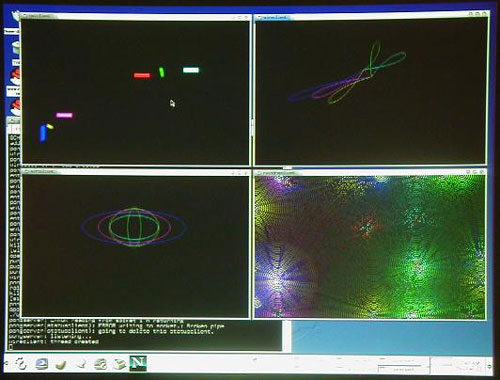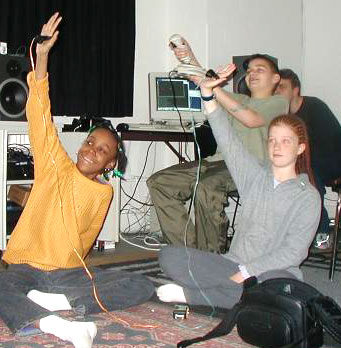
|
Kids in (Sound) Space: Technology introduction -- technology -- process and performance -- future work The primary technology used in "Kids in (Sound) Space" is the Pongserver, a new application being developed at the CMC. The Pongserver presents the performers with a graphical interface that represents a rectangular playing field filled with balls and paddles. The balls roll around the field bouncing off of the walls and paddles and more-or-less obeying the laws of physics. The paddles can be used to guide the balls into certain parts of the field, or to build structures or pathways on the field that will constrain the balls' movements. As a ball moves around the field its position is sent to a sound-producing program. This second program, called a client, creates or plays a prerecorded sound and uses the ball's positional data to change the features of that sound. For example, the client program might produce a simple whistling sound. As the ball moves across the field from left to right the client might move the location of the whistling sound from the left speaker to the right speaker. As the ball moves from the bottom of the field to the top the client might sweep the pitch of the whistling sound from low to high.
The mapping of a ball's position to a sound's features is not fixed. Performers can set up and experiment with many different mappings as they attempt to create and refine various types of sonic environments. A number of physical interfaces are used to enable the performers to control the balls and paddles in the playing field. These include joysticks, the computer mouse and a set of custom-built wireless accelerometers, which allow performers to control the computer by changing the positions of their hands. Other custom interfaces are being developed to encourage performers to use a variety of physical movements and gestures to control the action on the screen. In addition to clients that make and control sounds, there are a number of clients that draw on the screen. These graphical clients use the same control data as the sound-producing clients. So, for instance, as a performer moves a ball across the screen from left to right, one client might use that information to move a sound from left to right, while another might use the same information to increase the diameter of a circle. Because the control data being generated by the performers is abstract (it's simply a position in two-dimensional space) it can be mapped onto the parameters of many different sorts of objects. There's nothing that says that moving a ball from left to right has to map onto the spacial location of a sound; it could just as easily map onto the intensity of a light or the pitch of a voice.
This idea of mapping abstract, and in many ways arbitrary, information and actions from one domain to another is of tremendous importance, not only for the creation of contemporary music, but also for the process of working with contemporary technology in general. There is nothing inherent in the act of "double-clicking" an icon that means "open this file". As anyone who works with computers knows, the meaning of an action changes depending on the object that is being acted upon. Double-clicking on a file icon might mean "open this file", but double clicking on another icon might mean "empty the trash." Meanwhile, in real life double clicking on your watch button might mean "wake me up at 8:30!" Learning to thrive in this sort of abstract, open-ended technological environment is what "Kids in (Sound) Space" is all about. introduction -- technology -- process and performance -- future work |


